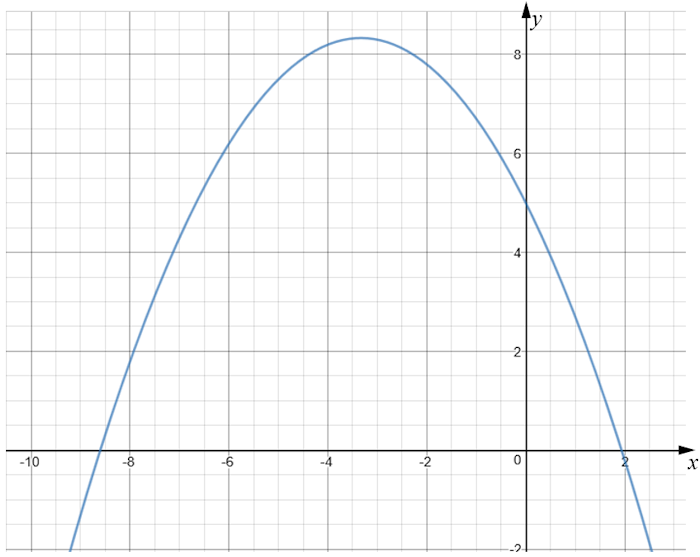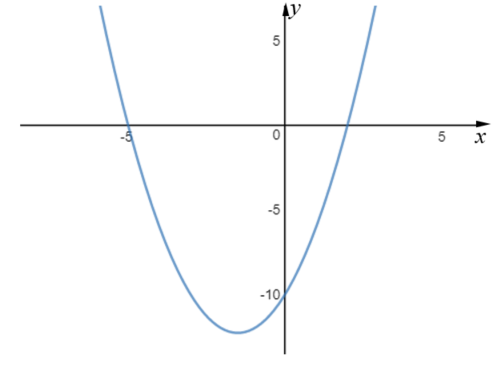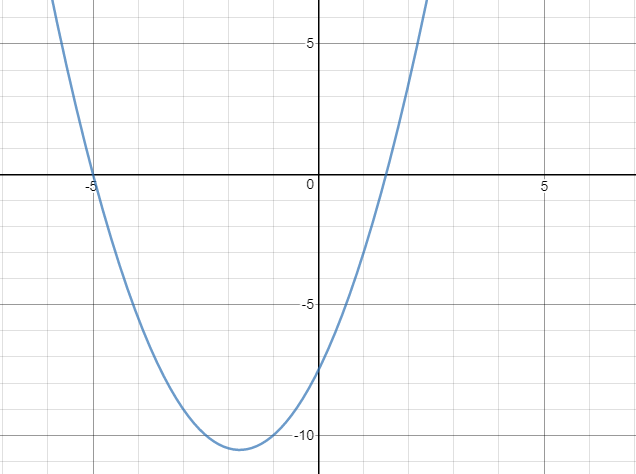
 |
Exam-Style Questions.Problems adapted from questions set for previous Mathematics exams. |
1. | GCSE Higher |
Write down the coordinates of the turning point on the graph of \(y = 9 - (x - 5)^2\)
2. | GCSE Higher |
The graph of the curve A with equation \(y=f(x)\) is transformed to give the graph of the curve B with equation \(y=5-f(x)\).
The point on A with coordinates (3, 9) is mapped to the point W on B.
Find the coordinates of W.
3. | GCSE Higher |
The graph of y = f(x) is drawn accurately on the grid.
(a) Write down the coordinates of the turning point of the graph.

(b) Write down estimates for the roots of f(x) = 0
(c) Use the graph to find an estimate for f(-5.5).
4. | GCSE Higher |
(a) By completing the square, solve \(x^2+8x+13=0\) giving your answer to three significant figures.
(b) From the completed square you found in part (a) find the minimum value of the curve \(y=x^2+8x+13\).
5. | GCSE Higher |
The graph of the following equation is drawn and then reflected in the x-axis
$$y = 2x^2 - 3x + 2$$(a) What is the equation of the reflected curve?
The original curve is reflected in the y-axis.
(b) What is the equation of this second reflected curve?
6. | GCSE Higher |
The diagram below is a sketch of a curve, a parabola, which is not drawn to scale.
The quadratic graph intersects the x-axis at (-5, 0) and at another point.
It also intersects the y-axis at (0, –10).
Work out the coordinates of the turning point of the graph if its equation is in the form \(y = x^2 + bx + c \).

7. | GCSE Higher |
(a) Find the interval for which \(x^2 - 9x + 18 \le 0\)
(b) The point (-4, -4) is the turning point of the graph of \(y = x^2 + ax + b\), where a and b are integers. Find the values of a and b.
8. | GCSE Higher |
(a) Write \(2x^2+8x+27\) in the form \(a(x+b)^2+c\) where \(a\), \(b\), and \(c\) are integers, by 'completing the square'
(b) Hence, or otherwise, find the line of symmetry of the graph of \(y = 2x^2+8x+27\)
(c) Hence, or otherwise, find the turning point of the graph of \(y = 2x^2+8x+27\)
9. | IB Analysis and Approaches |
Consider the function \(f(x)=\frac{1}{2}\left(2x-3\right)\left(x+5\right)\) for \(x \in \mathbb R\). The following diagram shows part of the graph of \(f\).

For the graph of \(f\)
(a) find the coordinates of the x-intercepts.
(b) find the coordinates of the vertex.
The function \(f\) can be written in the form \(f(x) = (x+h)^2 + k\)
(c) Write down the value of \(h\) and the value of \(k\).
10. | IB Standard |
A function is defined as \(f(x) = 2{(x - 3)^2} - 5\) .
(a) Show that \(f(x) = 2{x^2} - 12x + 13\).
(b) Write down the equation of the axis of symmetry of this graph.
(c) Find the coordinates of the vertex of the graph of \(f(x)\).
(d) Write down the y-intercept.
(e) Make a sketch the graph of \(f(x)\).
Let \(g(x) = {x^2}\). The graph of \(f(x)\) may be obtained from the graph of \(g(x)\) by the two transformations:
(f) Find the values of \(j\), \(k\) and \(s\).
11. | IB Standard |
\(f\) and \(g\) are two functions such that \(g(x)=3f(x+2)+7\).
The graph of \(f\) is mapped to the graph of \(g\) under the following transformations:
A vertical stretch by a factor of \(a\) , followed by a translation \(\begin{pmatrix}b \\c \\ \end{pmatrix}\)
Find the values of
(a) \(a\);
(b) \(b\);
(c) \(c\).
(d) Consider two other functions \(h\) and \(j\). Let \(h(x)=-j(2x)\). The point A(8, 7) on the graph of \(j\) is mapped to the point B on the graph of \(h\). Find the coordinates of B.
12. | IB Standard |
Let \(f(x)=5x^2-20x+k\). The equation \(f(x)=0\) has two equal roots.
(a) Write down the value of the discriminant.
(b) Hence, show that \(k=20\).
The graph of \(f\) has its vertex on the x-axis.
(c) Write down the solution of \(f(x)=0\).
(d) Find the coordinates of the vertex of the graph of \(f\).
The function can be written in the form \(f(x)=a(x-h)^2+j\).
(e) Find the value of \(a\).
(f) Find the value of \(h\).
(g) Find the value of \(j\).
(h) The graph of a function \(g\) is obtained from the graph of \(f\) by a reflection in the x-axis, followed by a translation by the vector \(\begin{pmatrix} 0 \\ 3 \\ \end{pmatrix} \). Find \(g\), giving your answer in the form \(g(x)=Ax^2+Bx+C\).
13. | IB Analysis and Approaches |
The functions \( f \) and \( g \) are defined for \( x \in \mathbb{R} \) by \( f(x) = 3 + 5x - 2x^2 \) and \( g(x) = x + k \), where \( k \in \mathbb{R} \).
(a) Find the range of \( f \).
(b) Given that \( (f \circ g)(x) \) has two distinct roots that sum to zero, determine the value of \( k \).
14. | IB Analysis and Approaches |
The graphs of the functions \(f(x)\), a parabola, and \(g(x)\), a straight line, meet at exactly one point.
$$f(x) = px^2 - px $$ $$g(x) = px-5 $$where \( x \in \mathbf R \text{ and } p \in \mathbf R \)
(a) Show that \(p = 5\)
The function \(f\) can be expressed in the form \(f(x) = 5(x-m)(x-n) \text{, where } m,n \in \mathbf R\)
(b) Find the value of \(m\) and the value of \(n\).
The function \(f\) can also be expressed in the form \(f(x) = 5(x-h)^2 + k, \text{ where } h,k \in \mathbf R\)
(c) Find the value of \(h\) and the value of \(k\).
(d) Hence find the values of \(x\) where the graph of \(f\) is both negative and decreasing.
If you would like space on the right of the question to write out the solution try this Thinning Feature. It will collapse the text into the left half of your screen but large diagrams will remain unchanged.
The exam-style questions appearing on this site are based on those set in previous examinations (or sample assessment papers for future examinations) by the major examination boards. The wording, diagrams and figures used in these questions have been changed from the originals so that students can have fresh, relevant problem solving practice even if they have previously worked through the related exam paper.
The solutions to the questions on this website are only available to those who have a Transum Subscription.
Exam-Style Questions Main Page
To search the entire Transum website use the search box in the grey area below.